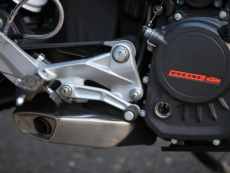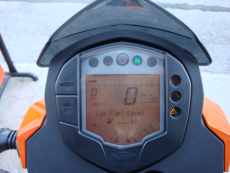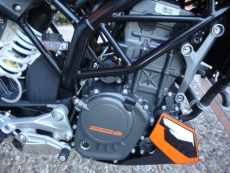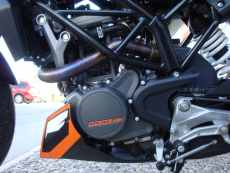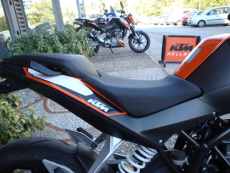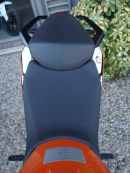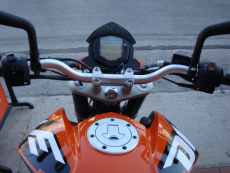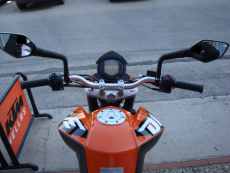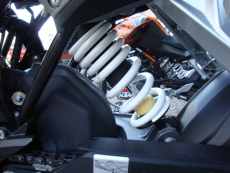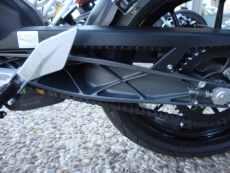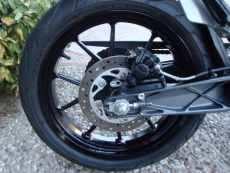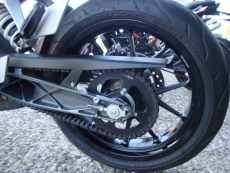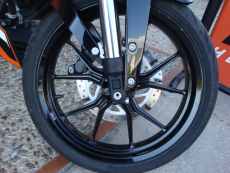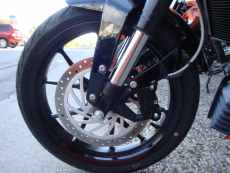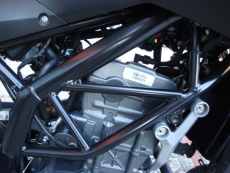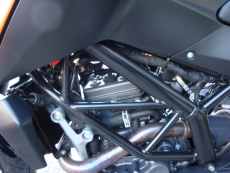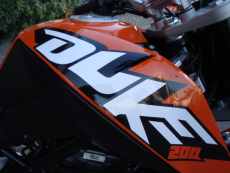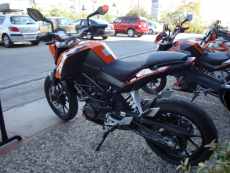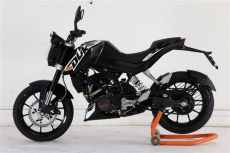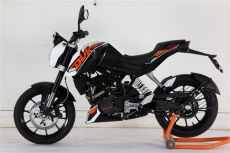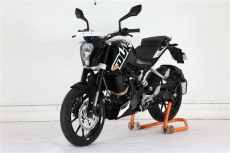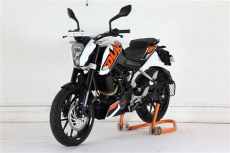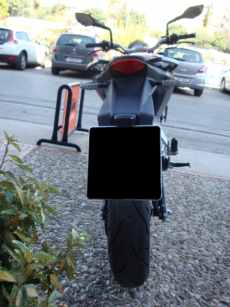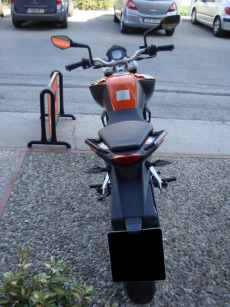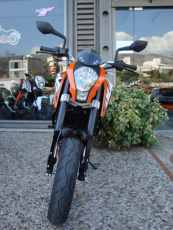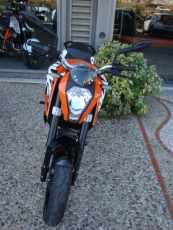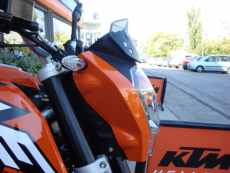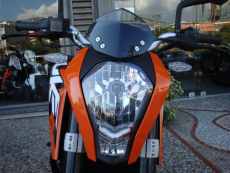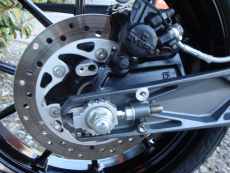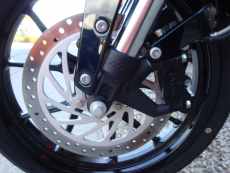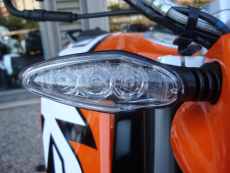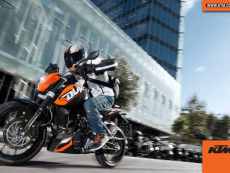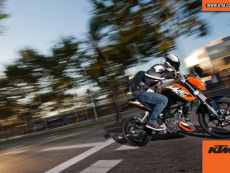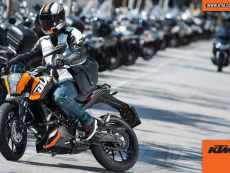Ktm Duke 200 (2012 - present): Although smaller, it doesnĘt play well with others!
Engine: The single cylinder liquid cooled 199.5 c.c. engine delivers 26 bhp/10000 rpm and 2 kgm / 8000 rpm (14.5 lbs ft) torque, claimed figures. The minimum required revs to obtain surge – free acceleration is 2500-3000 rpm, depending on the selected speed at the gearbox.
The engine response is not as linear as that of the Duke 125. Thus, increasing the engine revs, two power output steps may be noticed, the first at 6500 rpm and the second at 8000 rpm which is more discreet though. Riders who do not pay too much attention may not feel the difference.
Thus acceleration is relatively linear, up to the top speed of 134 km/h, (83.3 mph), where the limiter intervenes, very smoothly indeed. From the other hand, the rpm meter indication is fluctuating a lot at 10500 rpm where the rev limiter intervenes, so its not easy to tell the exact rpm number. Generally speaking, reading the rpm indication is a little elaborate procedure.
The torque and power provided are superb for this engine capacity, they belong to the 250 c.c. engine category. Compared to the smaller 125 c.c. brother, the greatest difference between the two becomes apparent. The performance of the Duke 200 belongs to a different league, either under acceleration or on everyday rides.
Therefore, torque and power surpass the needs of the would-be-average-rider in town, while a nimble rider will simply twist the throttle to the stop sometimes, when riding swiftly in urban areas.
Additionally overtaking on the open roads is easier now, although rider still has to take into account the moderate top speed. Eventually, both engines will accept a higher gear operation without usual surging, although, the Duke 200 will require much less downshifting than the Duke 125.
The engine revs given above, are rpm meter indications.
Like any Ktm faithful to the brandĘs roots, a decisive left foot is required to avoid false neutral gear engagement. The led gearshift indicator may be set to light up at the rpm threshold desired by the rider, for example at 7000 rpm during engine run - in. Engine is quite frugal in terms of fuel consumption, an indicative average figure is 3.8 l/100 km, (74 mpg Imperial), on nimble riding. Valve adjustment interval is short, 5000 km (3110 mi).
Riding position: The seat height is normal for a supermoto bike, that is 810 mm (31.9 in). Average stature riders or higher, will step a confident foot on the ground. Rider is placed mostly over the bike, riding position provides increased alertness, although its not a racing one. Rider's legs are placed slightly backwards. This would be very useful to a motorcycle designed for a drag strip, the Duke 200 has the privilege of being provocative at traffic lights, contrary to the smaller 125 c.c. little brother that has not right to challenge any big motorcycles around! The saddle for the pillion is slightly harsh.
The dimensions of the bike are small. The width of the handlebar is excluded, which is increased. Additionally the sides of the fuel tank seem to be vulnerable in case of a crash. It is a point that needs to be improved especially on a motorcycle which is mainly aimed to novice, yet passionate riders.
The bike feels light, 125 Kgs (276 lbs) ready to ride without fuel, claimed figure. That is just 1 kg (2.2 lbs) heavier than the 125 c.c. version.
On the road: An inverted 43 mm fork of average stiffness is equipped at the front. There is no linkage at the shock absorber which feels soft. The spring preload to the shock can be adjusted to 6 increments, itĘs the only suspension adjustment possible for the rider. The frame is steel, Trellis type.
The factory fitted tyres are MRF Reuz-c with dimensions 110/70-17 front, 150/60-17 rear. They are considered a moderate choice, especially on slippery roads. There are improved compounds at these dimensions for the rider to choose from.
On city rides the Duke 200 is an easy, daily, very agile and robust bike. It will fulfil the needs of the rider, providing swift and effective urban rides without any compromises asked.
On downtown rides the Duke 200 feels right at home exactly like the smaller 125 c.c. version. Steering lock is very good, it will be quite helpful to the rider in congested traffic.
The only possible compromise asked is due to the broad handlebar during filtering.
At this point both the handlebar's and mirrors' height is equal with carĘs and SUVĘs mirrors height respectively, which does not result in a great problem for the rider. Conclusively the Duke is not a top filtering bike for the 125-200 c.c. category standards.
Road imperfections are absorbed quite well, not superbly though. Perhaps for the younger age group that this bike is addressed to, comments about comfort might be something like this weekĘs useless information. However because older riders will buy it also, the front end provides good comfort over bumps, while the shock could do better. The suspension travel is 150 mm (5.9 in) front and rear.
The mirrors are marginally outside from the immediate riderĘs field of vision. In order to look through mirrors, rider should instantly get her/his eyes away from the road.
Eventually the Duke 200 is a motorcycle tempting the rider, who would wish to have a good excuse riding at a nimble pace across the city. Riding this bike is not an indifferent process even downtown.
If the rider is in the mood, she/he could hunt down much greater bikes, without feeling under-qualified, if of course the chase is conducted on increased traffic. Rider will feel then that once again little David may challenge many Goliaths in town and actually win sometimes!
On B- roads the Duke 200 still makes the owner proud. The superb agility, (wheelbase 1350 mm-53.14 in.), is combined with stability and robustness providing great rides. The Duke could be described as a solid game, although it's quite a serious one. Once again the difference with the Duke 125 is huge, mostly due to the provided torque.
At the fast pace the power provided by the 200 c.c. engine results to much greater excitement compared to the 125 c.c. Duke. Actually this is not very difficult to be achieved, about 2/3 of the bikes on the market can make it (depending on the country actually), its just a statement for comparison really. If riding was an electronic game, switching to Duke 200 feels like proceeding to Stage 2…
On low-average friction factor B-roads, feedback to the rider gets decreased. This is due to the factory fitted tyres, which set the riding limits when rider is smiling inside her/his helmet on roads like this.
If rider persists on charging, sliding away is close, no obvious prior warning is provided. If higher spec. tyres are fitted on this kind of roads, they would provide greater feedback and better progressiveness on a potential slide.
Finally, purposefully skidding at the entrance of the turn, that is ridden in motard style, is quite easy and confident. In case of a series of bumps when leaned hard, the shock will respond quite well.
On faster turns, a street bike style could be adopted, the Duke is very stable, although feedback to the rider is average once more. The small pillion seat serves as a stop for the rider then. Due to the small weight and fast steering geometry, this riding style is not easily recommended. The 200 c.c. engine still feels small to a nimble rider then, although it will fulfil the expectations of any average rider, regarding at least the speed maintained mid-turn.
However replacing the tires with a smarter compound is the first and perhaps the only major required upgrade to the Duke 200. Of course, the same applies to the smaller 125 c.c. version, although the weaker performance of that engine doesnĘt push the tires to their limits that often.
On high friction factor B-roads, rider will be overwhelmed even at the fast pace. Rider feels like mastering an integrated bike. The engine performance is the problem faced by the rider then, engine rpm should be kept higher than 7000. Feedback to the rider could be slightly better, riding too fast.
A high cornering speed will be achieved, throttle off engine operation will be rare. If rider could up-shift at 10000 rpm, that would be ideal.
Except from the engine, the rest parts of the bike have no problem whatsoever to take the load in conditions like these, the Duke 200 could be a quite more powerful bike, no problem with that.
For anyone who is interested in such riding conditions, changing tyres and will again be required, although not as urgently as described in the case of low friction factor roads. It would provide though improved feedback and confidence to the rider.
Rider will find it difficult to lean the Duke as much as the edges of the rear tire, which is a hint that the 150 mm rear tire is slightly wider than ideal for the 4 in. rear rim.
On the highway the little Duke will be a satisfying bike only on short rides. Indicatively the speed of 100 km/h (62 mph) corresponds to 7500 rpm, while stability provides great confidence. Of course air protection is negligible, although the moderate top speed of 134 km/h (83.3 mph), will not require any kind of air protection. Conclusively, some planning due to the top speed, prior to overtaking, is the only requirement on short highway rides.
On dirt roads the racing genes cannot be hidden. The Duke is a robust and effective motorcycle. In other words itĘs a fun bike, the safety limits will be set by the on-road tires on bikes like this. Comfort to the rider could be better, revealing DukeĘs on-road oriented set-up.
Single disc brakes, 300 mm front and 230 mm rear are equipped. A four piston radial calliper is equipped at the front, a single piston calliper at the rear, steel brake lines, at both ends. The front brake is very powerful providing good initial bite. The rear brake is powerful, providing a strong initial bite, while feedback to the rider is relatively good at both ends.
The brakes are superb for an experienced biker. The Duke 200 could become an endo-bike with superb potential for this age group, probably the first stunt-bike for a young biker! The feedback from the front wheel lock could be improved after the OE tire change. Therefore, a unique compromise will be required due to the power of the front brake. That is the need for smarter tyres when the motorcycle is used on low friction factor roads.
Model history/versions/optional/reliability/build quality: The Duke 125 was introduced in 2011. A year later the Duke 200 was presented. Their only difference is located to the engine.
The digital display is superb. Turning the key, a “ready to race” welcome message is displayed. Perhaps Ktm is one of the very few companies that actually mean it in the 125-200 c.c. category. The design similarities with the 690 c.c. big brother, especially concerning the aluminium swingarm and the under-belly exhaust, are important for a 125-200 c.c. motorcycle. The symbols on the handlebar switches light up internally. Indicators and rear light use led lights.
The Duke 125-200 is manufactured in India by the Bajaj company, partner of Ktm, under high Ktm regulations. The bike parts come from India, China, Poland, some of these companies involved are subsidiaries of well-known European brands like Brembo-WP. It is something that Europeans and other manufacturers are now implementing, one or the other way.
There are no specific reliability issues. Build quality is very-very good. The finish is also very good, nothing more than that though.
Comments: The design of the bike is very youthful, energetic, full of bold angles and lines.
Pillion handgrips are very beautiful. A striking view is obtained from the riding position, full of angles from the fuel tank, mirrors, instrument and the fly-screen. Certainly this image is unique for the Dukes 125 and 200, it cannot be mistaken with any other bike! Many people will find this bike to be very seductive.
Ktm manufactured a bike with excellent specifications and road handling, on a relatively low cost. The company conducted a six months research throughout Europe in order to comprehend the taste of young riders concerning their first motorcycle. It is known that the age of the average motorcyclist is increasing fast in Western countries, unfortunately.
The Duke 200 is a superb bike aiming to novice riders willing to learn riding and raise the level of their adrenaline at will, safety first.
Compared to the Duke 125, in theory their engine capacity difference may seem small, however in terms of riding the Duke 200 is a much better and integrated bike, its almost completely different yet marginally more expensive bike. It is recommended to the riders who are thinking of buying the Duke 125, while their riding licence is adequate for the 200 c.c. version also.
‘he Duke 200 does not provide the on-road smoothness that the other kids of the class exhibit, that is the 250 on-off bikes like the Kawasaki KLX, Honda CRF and the naked Sym SB 250 Ni Wolf (‘2).The Duke 200 likes to play in town and on twisty B-roads, but if his classmates come there and challenge him, he will probably try to bite them!
The selection of the specific 200 c.c. engine capacity was in purpose, first to provide sufficient gap from the 125 and the oncoming Duke 390 versions. Additionally a 250 c.c. variant would seem even bigger and more expensive bike in huge, rising markets like India. Therefore, Ktm will fully satisfy the expectations of every global novice biker and even more than that.
However in the case of the Duke 200, rider will certainly be wondering “if a 200 c.c. bike is that good, what would it be like if it featured a 250 c.c. engine, which is the capacity of the competition?” And then, “what about a full-faired version?” Well, this would make more sense in the case of the Duke 390 coming in 2013.
A video created by Ktm in order to reassure the Indian future customers for the monsoon season because of the under-belly exhaust!
Price: 4290 Euros
+ Handling
+ Integrated bike for novice riders willing to improve their skills
+ Economy oriented (purchase-fuel consumption)
- Factory fitted tires
- Smaller engine capacity than the competition



